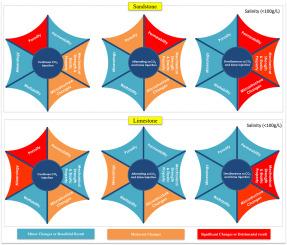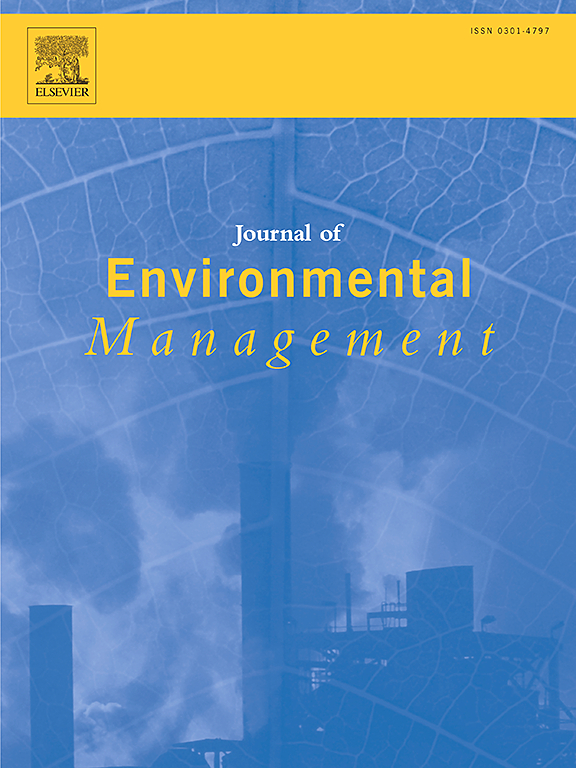Produced water integration in CO2 storage using different injection strategies: The effect of salinity on rock petrophysical, mineralogy, wettability and geomechanical properties
IF 8
2区 环境科学与生态学
Q1 ENVIRONMENTAL SCIENCES
引用次数: 0
Abstract
Optimizing CO2 storage efficiency in Deep saline aquifers (DSA) involves improving each storage trapping mechanism, such as structural/stratigraphy, capillary/residual, mineral, and dissolution trapping mechanisms, while maintaining the reservoir integrity for long-term carbon capture and storage (CCS). These enhancements are driven by a series of geochemical reactions that favorably modify petrophysical, mineralogy, wettability, rock geomechanics of the rock, and dissolution of CO2 in aquifer fluid. Three different CO2 injection strategies have been identified and tested for optimizing CO2 storage and efficiency- Continuous CO2 injection (CCI), Water Alternating Gas (WAG), and Simultaneous scCO2-brine Aquifer Injection (SAI). This study investigates the effect of integrating produced water (PW) into WAG and SAI strategies for CO2 storage, emphasizing how the salinity of the injected water affects reservoir properties alterations in sandstone and limestone formations exposed to scCO2. Experimental results show that high salinity levels accelerate mineralogy changes and wettability alteration, particularly in limestone, leading to porosity, permeability, and mechanical strength changes. While the SAI results showed more aggressive and detrimental changes in rock properties, WAG leads to slower reaction rates, a more stable and effective strategy with more gradual alterations in rock properties due to its ability to balance fluid flow and mechanical strength, hence offering greater stability for long-term CO2 storage. Based on these findings, a 20–50 g/L salinity range is recommended to maintain reservoir integrity and reduce the negative impacts of salinity on CO2 storage efficiency and storage. This study provides valuable insights for optimizing CO2 storage in DSAs, enhancing environmental sustainability, and enhancing mineral trapping through more targeted geochemical reactions and lower changes in rock mechanical strength.

采用不同注入策略将采出水纳入二氧化碳封存:盐度对岩石岩石物理、矿物学、润湿性和地质力学特性的影响。
优化深层含盐含水层(DSA)的二氧化碳封存效率涉及改进每一种封存捕集机制,如结构/地层、毛细管/残余、矿物和溶解捕集机制,同时保持储层的完整性,以实现长期碳捕集与封存(CCS)。一系列地球化学反应对岩石物理、矿物学、润湿性、岩石地质力学以及二氧化碳在含水层流体中的溶解等方面产生了有利的影响,从而推动了这些方面的改善。为了优化二氧化碳封存和提高效率,已经确定并测试了三种不同的二氧化碳注入策略--连续二氧化碳注入(CCI)、水交替气体注入(WAG)和scCO2-盐水同时注入含水层(SAI)。本研究探讨了将采出水(PW)纳入 WAG 和 SAI 战略进行二氧化碳封存的效果,强调了注入水的盐度如何影响暴露于 scCO2 的砂岩和石灰岩地层的储层性质变化。实验结果表明,高盐度会加速矿物学变化和润湿性改变,尤其是在石灰岩中,从而导致孔隙度、渗透率和机械强度的变化。虽然 SAI 的结果显示岩石性质的变化更剧烈、更有害,但 WAG 的反应速度更慢,是一种更稳定、更有效的策略,由于它能够平衡流体流动和机械强度,岩石性质的变化更渐进,因此为二氧化碳的长期封存提供了更大的稳定性。基于这些研究结果,建议盐度范围为 20-50 克/升,以保持储层的完整性,减少盐度对二氧化碳封存效率和封存的负面影响。这项研究为优化 DSA 中的二氧化碳封存、提高环境可持续性以及通过更有针对性的地球化学反应和更低的岩石机械强度变化提高矿物捕集能力提供了宝贵的见解。
本文章由计算机程序翻译,如有差异,请以英文原文为准。
求助全文
约1分钟内获得全文
求助全文
来源期刊

Journal of Environmental Management
环境科学-环境科学
CiteScore
13.70
自引率
5.70%
发文量
2477
审稿时长
84 days
期刊介绍:
The Journal of Environmental Management is a journal for the publication of peer reviewed, original research for all aspects of management and the managed use of the environment, both natural and man-made.Critical review articles are also welcome; submission of these is strongly encouraged.
 求助内容:
求助内容: 应助结果提醒方式:
应助结果提醒方式:


